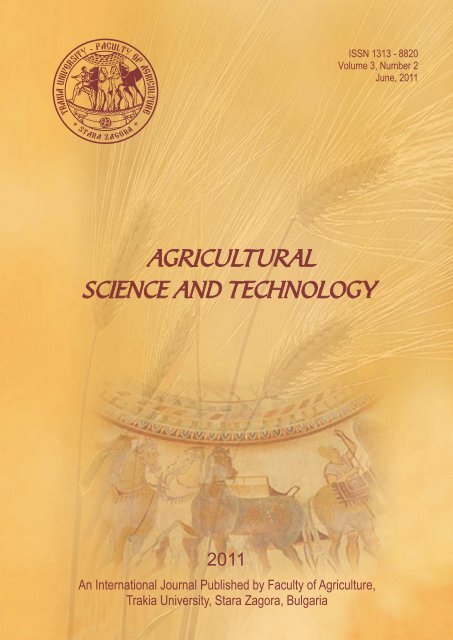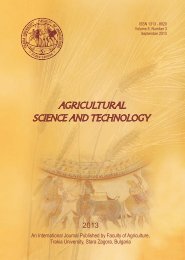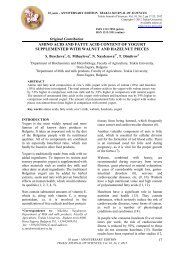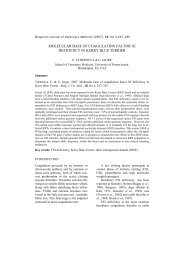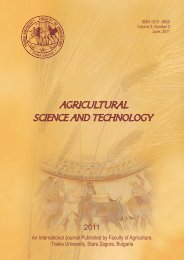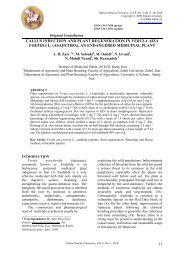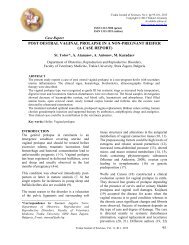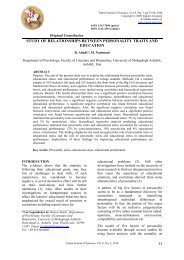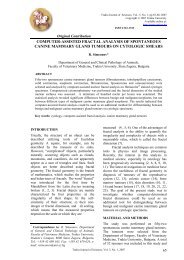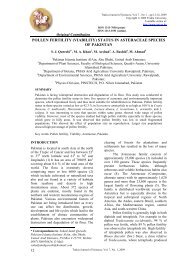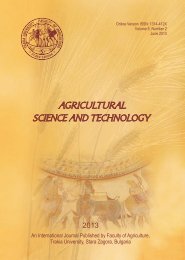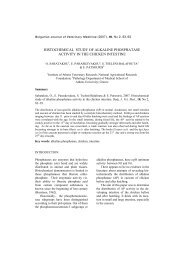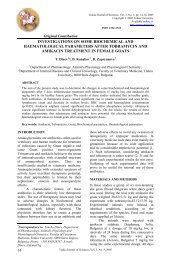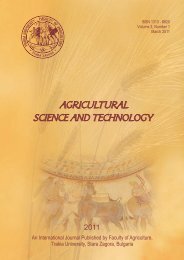You also want an ePaper? Increase the reach of your titles
YUMPU automatically turns print PDFs into web optimized ePapers that Google loves.
%25.0020.0015.0010.005.000.00-5.00-10.00-15.00-20.00-25.00Period 1 Period 2 Period 3Day <strong>of</strong> LactationMilk Yield per LactationDaily Milk YieldFigure 4. Cow’s characteristics - “Last quota”%30.0025.0020.0015.0010.005.000.00-5.00-10.00-15.00-20.00-25.00Period 1 Period 2 Period 3Day <strong>of</strong> LactationMilk Yield per LactationDaily Milk YieldFigure 5. Cow’s characteristics - “Middle quota”groups <strong>of</strong> <strong>cows</strong> were formed <strong>in</strong> the herd, we aimed to <strong>in</strong>vestigate the traits <strong>of</strong> <strong>cows</strong> form<strong>in</strong>g the predom<strong>in</strong>ant “middle” quota (about 60%),<strong>in</strong>dividual traits <strong>of</strong> animals <strong>in</strong> them and their change over time. we have established that these were highly productive animals –Figure 3 presents the deviations from the herd average with lactation milk yield by 22% higher than the average one (Figureparameters for the so-called “first” group – <strong>cows</strong> first to enter for 5). These <strong>cows</strong> formed the average values <strong>of</strong> the daily milkthmilk<strong>in</strong>g. By the 60 day, these were animals <strong>in</strong> a more advanced production and lactation day (with the exception <strong>of</strong> the first 60 daysstage <strong>of</strong> lactation, with lower lactation milk yield and average daily when they were <strong>in</strong> early lactation).milk production close to the herd average production. After 4months, the values <strong>of</strong> all parameters were very close to the herdrdaverage ones. By the 3 period, <strong>cows</strong> that were first to enter for Conclusionsmilk<strong>in</strong>g had a higher daily milk yield, lower lactation milk yield andwere <strong>in</strong> a earlier stage <strong>of</strong> lactation. Cows from the “last” quota (FigureCows observed a specific order when enter<strong>in</strong>g the milk<strong>in</strong>g4) were always with a lower lactation milk yield and were <strong>in</strong> a later<strong>parlour</strong>. The entrance order for milk<strong>in</strong>g was mostly <strong>in</strong>fluenced by thestage <strong>of</strong> lactation as compared to herd average. Investigat<strong>in</strong>g the110
stage <strong>of</strong> lactation and at the least extent – by the daily milk heart rate dur<strong>in</strong>g milk<strong>in</strong>g. Applied Animal Behavior Science, 55, 213-production. Cows exhibited a clear preference to milk<strong>in</strong>g side, 229.especially marked <strong>in</strong> animals that were last to enter the <strong>parlour</strong> (over Lauwere C, Hendriks M, Metz J and Schouten W, 1988.70%). In a herd <strong>of</strong> 100 <strong>cows</strong>, three groups are formed with respect to <strong>Behaviour</strong> <strong>of</strong> dairy <strong>cows</strong> under free or forced cow traffic <strong>in</strong> athe entrance order for milk<strong>in</strong>g: 16% that tended to enter first, 18-25% simulated automatic milk<strong>in</strong>g system environment. Applied Animalthat are always the last, and the largest, 'tolerant” group <strong>of</strong> 50-66%. <strong>Behaviour</strong> Science, 56,1, 13-28.Highly productive <strong>cows</strong> are never the majority among those that are Tanner M, Grand<strong>in</strong> T, Cattell M and Dees<strong>in</strong>g M, 1994. Thefirst or last to enter for milk<strong>in</strong>g.relationship between facial hair whorls and milk<strong>in</strong>g <strong>parlour</strong> sideThe analysis <strong>of</strong> results did not allow us to determ<strong>in</strong>e precisely preference. Journal <strong>of</strong> Animal Science, 72, 207.the proportion <strong>of</strong> the effect <strong>of</strong> <strong>in</strong>dividual traits or the environment on Tossev A, Varlyakov I and Sivkova K, 1989. Cow's behaviour <strong>in</strong>the normal milk let-down reflex. It could be however affirmed that <strong>in</strong> <strong>in</strong>dustrial type <strong>of</strong> hous<strong>in</strong>g. A review. Academy <strong>of</strong> Agriculture, S<strong>of</strong>ia,all <strong>in</strong>stances, the specific traits <strong>of</strong> <strong>cows</strong> <strong>in</strong> a successful production ISBN 636.2:612.8:591.5:338.924(047).system should be taken <strong>in</strong>to consideration. In general - the Paranhos da Costa M and Broom D, 2001. Consistency <strong>of</strong> sideconclusion with most substantial practical effect is that when rear<strong>in</strong>g choice <strong>in</strong> the milk<strong>in</strong>g <strong>parlour</strong> by Holste<strong>in</strong>-Friesian <strong>cows</strong> and itsconditions <strong>in</strong>duce an impaired entrance order <strong>in</strong> the milk<strong>in</strong>g <strong>parlour</strong> relationship with their reactivity and milk yield. Applied Animaland/or do not allow <strong>cows</strong> tak<strong>in</strong>g the preferred milk<strong>in</strong>g site, we prеdict <strong>Behaviour</strong> Science, 70, 177-186.stress <strong>in</strong> animals and productivity breakdown.Rathore A, 1982. Order <strong>of</strong> cow entry at milk<strong>in</strong>g and its relationshipwith milk yield and consistency <strong>of</strong> the order. Applied Animal Ethology,8, 45-52.Re<strong>in</strong>hardt V, 1973. Social rank order and milk<strong>in</strong>g order <strong>in</strong> <strong>cows</strong>.ReferencesZeitschrift fuer Tierpsycology, 32, 281-292.Varlyakov I, 1989. Ethological evaluation <strong>of</strong> two technologies forBouissou M, Boissy A, Le Ne<strong>in</strong>dre P and Veissier I, 2001. The free hous<strong>in</strong>g <strong>of</strong> dairy <strong>cows</strong>. Thesis for PhD, Higher Institute forsocial behaviour <strong>of</strong> cattle. In: Social behaviour <strong>in</strong> farm animals (eds Zootechnics and Veter<strong>in</strong>ary Medic<strong>in</strong>e, Stara Zagora, 236 pp. (Bg).L. Keel<strong>in</strong>g and H. Gonyou). CAB International, Wall<strong>in</strong>gford, UK. Varlyakov I, 1992. A group behavior <strong>of</strong> <strong>cows</strong> observed at milk<strong>in</strong>g <strong>in</strong> aCeballos A and Weary D, 2002. Feed<strong>in</strong>g small quantities <strong>of</strong> gra<strong>in</strong> <strong>in</strong> milk<strong>in</strong>g <strong>parlour</strong>. Proceed<strong>in</strong>gs <strong>of</strong> the II-nd International Ethologicalthe <strong>parlour</strong> facilitates pre-milk<strong>in</strong>g handl<strong>in</strong>g <strong>of</strong> dairy <strong>cows</strong>: a note. Youth Meet<strong>in</strong>g,Godollo. July 26 - August 8. Hungary, 245.Applied Animal Behavior Science, 77, 249-254.Varlyakov I and Tossev A, 1989. <strong>Behaviour</strong> <strong>of</strong> <strong>cows</strong> observed atGrasso F, De Rosa G, Napolitano F, Di Francia A and Bordi A, milk<strong>in</strong>g <strong>in</strong> a milk<strong>in</strong>g <strong>parlour</strong>. Proceed<strong>in</strong>gs <strong>of</strong> International Symposium2007. Entrance order and side preference <strong>of</strong> dairy <strong>cows</strong> <strong>in</strong> the “Ethology <strong>of</strong> Farm Animals”, 2-6 October 1988, Eberswalde,milk<strong>in</strong>g <strong>parlour</strong>. Italian Journal <strong>of</strong> Animal Science, 6, 187-194. Tierhygiene-Information, Eberswalde-F<strong>in</strong>ow-21, (1989), 77, 3-8.Hasegawa N, Nishiwaki A, Sugawara K and Ito I, 1997. The Varlyakov I and Tossev A, 1990. Investigation on milk<strong>in</strong>g reflex <strong>in</strong>effects <strong>of</strong> social exchange between two groups <strong>of</strong> lactat<strong>in</strong>g milk<strong>in</strong>g <strong>parlour</strong> “Herr<strong>in</strong>gbone” type. Proceed<strong>in</strong>gs <strong>of</strong> scientific sessionprimiparous heifers on milk production, dom<strong>in</strong>ance order, behavior on Faculty <strong>of</strong> Animal Sience, 4 May, Stara Zagora, 1.and adrenocortical response. Applied Animal Behavior Science, 51, Wasilewski A, 1999. Demonstration and verification <strong>of</strong> a milk<strong>in</strong>g15-27. order <strong>in</strong> dairy sheep and its extent and consistency. Applied AnimalHopster H, van der Werf J and Blokhuis H, 1998. Side preference <strong>Behaviour</strong> Science, 64, 111-124.<strong>of</strong> dairy <strong>cows</strong> <strong>in</strong> the milk<strong>in</strong>g <strong>parlour</strong> and its effects on behaviour and111
AGRICULTURAL SCIENCE AND TECHNOLOGY, VOL. 3, No 2, 2011CONTENTS 1 / 2Genetics and Breed<strong>in</strong>gEffect <strong>of</strong> the age at first calv<strong>in</strong>g on test day production traits <strong>in</strong> black-and-white <strong>cows</strong>Zh. GergovskaEgg production potential <strong>of</strong> Manchurian Golden quail breedersA. GenchevVariability and stability <strong>of</strong> yield and quality <strong>of</strong> gra<strong>in</strong> <strong>of</strong> several bread wheat cultivarsN. Tsenov, I. Stoeva, T. Gubatov, V. PeevaProductive and quality characteristics <strong>of</strong> brown cottonA. Stoilova, I. Saldzhiev , Zh. TerzievSuperovulation and embryo transfer <strong>in</strong> goats by us<strong>in</strong>g PMSG or FSHA. Pampukidou, T. Alifakiotis, M. Avdi, R. Ivanova6773818894Nutrition and PhysiologyEffect <strong>of</strong> dietary am<strong>in</strong>o acid concentration on nitrogen balance <strong>in</strong> PIC hybrid pigsA. Ilchev, G. GanchevComparative studies on some parameters <strong>of</strong> <strong>in</strong>nate resistance and metabolic pr<strong>of</strong>ile <strong>of</strong> sheep and their <strong>of</strong>fspr<strong>in</strong>gdepend<strong>in</strong>g on the rationB. Bivolarski, Е. Vachkova, S. Laleva, P. Slavova, I. Ivanov<strong>Behaviour</strong> <strong>of</strong> <strong>cows</strong> <strong>in</strong> milk<strong>in</strong>g <strong>parlour</strong>I. Varlyakov, V. Radev, Т. Slavov, N. Grigorova98103107Production SystemsFeed<strong>in</strong>g value <strong>of</strong> spr<strong>in</strong>g vetch (Vicia sativa L.) <strong>in</strong>fluenced by preparations with different biological effectY. Naydenova, N. Georgieva, I. NikolovaImpact <strong>of</strong> mixtures between retardants and comb<strong>in</strong>ed herbicides on the sow<strong>in</strong>g properties <strong>of</strong> the durum wheatG. DelchevPr<strong>of</strong>ile <strong>of</strong> lavender oil from second harvestG. Zhekova, N. NedkovEssential oil content and composition <strong>of</strong> Thyme “German w<strong>in</strong>ter”G. Zhekova, A. Dzhurmanski, M. NikolovaEffect <strong>of</strong> some agronomy factors on the cook<strong>in</strong>g properties <strong>of</strong> lentil seeds (Lens cul<strong>in</strong>aris Medic L.)G. MilevComparative study <strong>of</strong> different varieties <strong>of</strong> red clover <strong>in</strong> Bulgarian conditionsTs. Mihovski, B. Chourcova, D. MitevStudy on the level <strong>of</strong> generated vacuum <strong>in</strong> the teat cup milk<strong>in</strong>g chamber as a factor for assess<strong>in</strong>g l<strong>in</strong>er suitabilityV. Vlashev, G. D<strong>in</strong>eva112117121123126130134
CONTENTS2 / 2Agriculture and EnvironmentContent <strong>of</strong> heavy metals and metalloids <strong>in</strong> bees and bee products from areas with different degree <strong>of</strong>anthropogenic impactI. Zhelyazkova, S. Atanasova, V. Barakova, G. MihaylovaSpecies composition <strong>of</strong> weeds <strong>in</strong> wheat and barleyM. Georgiev, D. Pavlov, G. Beev, M. Gerdzikova, R. BazitovVariability <strong>of</strong> some biologically active compounds <strong>of</strong> Tribulus terrestris L.M. Nikolova, A. Ivanova, I. Lazarova, D. Peev, N. ValyovskaOrganic matter status <strong>in</strong> reclaimed Technosols <strong>of</strong> BulgariaV. Tsolova, M. Banov136143150155Product Quality and SafetyUse <strong>of</strong> near<strong>in</strong>frared spectroscopy technology with a remote reflectance fibre-optic probe for predict<strong>in</strong>g <strong>of</strong> traceelements contents <strong>in</strong> tobaccoL. Dospatliev, S. AtanassovaOccurrence and distribution <strong>of</strong> Fusarium species <strong>in</strong> wheat gra<strong>in</strong>G. Beev, S. Denev, D. PavlovInfluence the extraction acidity level on the amount and chemical composition <strong>of</strong> essential oil from Rosadamascena Mill.A. DobrevaDistribution <strong>of</strong> moisture <strong>in</strong> the soil pr<strong>of</strong>ile <strong>in</strong> terms <strong>of</strong> two soil typesA. Stoyanova, M. TodorovaSlaughter<strong>in</strong>g analysis and chemical composition <strong>of</strong> rabbit meatA.Kuzelov, E. Atanasova, T. AngelkovaGra<strong>in</strong> sample quality assessment us<strong>in</strong>g Intechn and Unscrambler platformsM. Mladenov, Ts. Draganova, R. Tsenkova160165169172176179
Instruction for authorsPreparation <strong>of</strong> papersPapers shall be submitted at the editorial<strong>of</strong>fice typed on standard typ<strong>in</strong>g pages (A4,30 l<strong>in</strong>es per page, 62 characters per l<strong>in</strong>e).The editors recommend up to 15 pages forfull research paper ( <strong>in</strong>clud<strong>in</strong>g abstractreferences, tables, figures and otherappendices)The manuscript should be structured asfollows: Title, Names <strong>of</strong> authors andaffiliation address, Abstract, List <strong>of</strong>keywords, Introduction, Material andm e t h o d s , R e s u l t s , D i s c u s s i o n ,Conclusion, Acknowledgements (if any),References, Tables, Figures.The title needs to be as concise and<strong>in</strong>formative about the nature <strong>of</strong> research. Itshould be written with small letter /bold, 14/without any abbreviations.Names and affiliation <strong>of</strong> authorsThe names <strong>of</strong> the authors should bepresented from the <strong>in</strong>itials <strong>of</strong> first namesfollowed by the family names. Thecomplete address and name <strong>of</strong> the<strong>in</strong>stitution should be stated next. Theaffiliation <strong>of</strong> authors are designated bydifferent signs. For the author who is go<strong>in</strong>gto be correspond<strong>in</strong>g by the editorial boardand readers, an E-mail address andtelephone number should be presented asfootnote on the first page. Correspond<strong>in</strong>gauthor is <strong>in</strong>dicated with *.Abstract should be not more than 350words. It should be clearly stated what newf<strong>in</strong>d<strong>in</strong>gs have been made <strong>in</strong> the course <strong>of</strong>research. Abbreviations and references toauthors are <strong>in</strong>admissible <strong>in</strong> the summary. Itshould be understandable without hav<strong>in</strong>gread the paper and should be <strong>in</strong> oneparagraph.Keywords: Up to maximum <strong>of</strong> 5 keywordsshould be selected not repeat<strong>in</strong>g the titlebut giv<strong>in</strong>g the essence <strong>of</strong> study.The <strong>in</strong>troduction must answer thefollow<strong>in</strong>g questions: What is known andwhat is new on the studied issue? Whatnecessitated the research problem,described <strong>in</strong> the paper? What is yourhypothesis and goal ?Material and methods: The objects <strong>of</strong>research, organization <strong>of</strong> experiments,chemical analyses, statistical and othermethods and conditions applied for theexperiments should be described <strong>in</strong> detail.A criterion <strong>of</strong> sufficient <strong>in</strong>formation is to bepossible for others to repeat theexperiment <strong>in</strong> order to verify results.Results are presented <strong>in</strong> understandabletables and figures, accompanied by thestatistical parameters needed for theevaluation. Data from tables and figuresshould not be repeated <strong>in</strong> the text.Tables should be as simple and as few aspossible. Each table should have its ownexplanatory title and to be typed on aseparate page. They should be outside thema<strong>in</strong> body <strong>of</strong> the text and an <strong>in</strong>dicationshould be given where it should be<strong>in</strong>serted.Figures should be sharp with goodcontrast and rendition. Graphic materialsshould be preferred. Photographs to beappropriate for pr<strong>in</strong>t<strong>in</strong>g. Illustrations aresupplied <strong>in</strong> colour as an exception afterspecial agreement with the editorial boardand possible payment <strong>of</strong> extra costs. Thefigures are to be each <strong>in</strong> a s<strong>in</strong>gle file andtheir location should be given with<strong>in</strong> thetext.Discussion: The objective <strong>of</strong> this sectionis to <strong>in</strong>dicate the scientific significance <strong>of</strong>the study. By compar<strong>in</strong>g the results andconclusions <strong>of</strong> other scientists thecontribution <strong>of</strong> the study for expand<strong>in</strong>g ormodify<strong>in</strong>g exist<strong>in</strong>g knowledge is po<strong>in</strong>tedout clearly and conv<strong>in</strong>c<strong>in</strong>gly to the reader.Conclusion: The most important consequencesfor the science and practiceresult<strong>in</strong>g from the conducted researchshould be summarized <strong>in</strong> a few sentences.The conclusions shouldn't be numberedand no new paragraphs be used.Contributions are the core <strong>of</strong> conclusions.References:In the text, references should be cited asfollows: s<strong>in</strong>gle author: Sandberg (2002);two authors: Andersson and Georges(2004); more than two authors: Anderssonet al.(2003). When several references arecited simultaneously, they should beranked by chronological order e.g.:(Sandberg, 2002; Andersson et al., 2003;Andersson and Georges, 2004).References are arranged alphabetically bythe name <strong>of</strong> the first author. If an author iscited more than once, first his <strong>in</strong>dividualpublications are given ranked by year, thencome publications with one co-author, twoco-authors, etc. The names <strong>of</strong> authors,article and journal titles <strong>in</strong> the Cyrillic oralphabet different from Lat<strong>in</strong>, should betransliterated <strong>in</strong>to Lat<strong>in</strong> and article titlesshould be translated <strong>in</strong>to English.The orig<strong>in</strong>al language <strong>of</strong> articles and bookstranslated <strong>in</strong>to English is <strong>in</strong>dicated <strong>in</strong>parenthesis after the bibliographicreference (Bulgarian = Bg, Russian = Ru,Serbian = Sr, if <strong>in</strong> the Cyrillic, Mongolian =Мо, Greek = Gr, Georgian = Geor.,Japanese = Jа, Ch<strong>in</strong>ese = Ch, Arabic = Аr,etc.)The follow<strong>in</strong>g order <strong>in</strong> the reference list isrecommended:Journal articles: Author(s) surname and<strong>in</strong>itials, year. Title. Full title <strong>of</strong> the journal,volume, pages. Example:Simm G, Lewis RM, Grundy B andD<strong>in</strong>gwall WS, 2002. Responses toselection for lean growth <strong>in</strong> sheep. AnimalScience, 74, 39-50Books: Author(s) surname and <strong>in</strong>itials,year. Title. Edition, name <strong>of</strong> publisher,place <strong>of</strong> publication. Example:Oldenbroek JK, 1999. Genebanks andthe conservation <strong>of</strong> farm animal geneticresources, Second edition. DLO Institutefor Animal Science and Health,Netherlands.Book chapter or conference proceed<strong>in</strong>gs:Author(s) surname and <strong>in</strong>itials, year. Title.In: Title <strong>of</strong> the book or <strong>of</strong> the proceed<strong>in</strong>gsfollowed by the editor(s), volume, pages.Name <strong>of</strong> publisher, place <strong>of</strong> publication.Example:Mauff G, Pulverer G, Operkuch W,Hummel K and Hidden C, 1995. C3-variants and diverse phenotypes <strong>of</strong>unconverted and converted C3. In:Provides <strong>of</strong> the Biological Fluids (ed. H.Peters), vol. 22, 143-165, PergamonPress. Oxford, UK.Todorov N and Mitev J, 1995. Effect <strong>of</strong>level <strong>of</strong> feed<strong>in</strong>g dur<strong>in</strong>g dry period, and bodycondition score on reproductivet hperformance <strong>in</strong> dairy <strong>cows</strong>, IXInternational Conference on ProductionDiseases <strong>in</strong> Farm Animals, Sept.11 – 14,Berl<strong>in</strong>, Germany, p. 302 (Abstr.).Thesis:Penkov D, 2008. Estimation <strong>of</strong> metabolicenergy and true digestibility <strong>of</strong> am<strong>in</strong>o acids<strong>of</strong> some feeds <strong>in</strong> experiments with muscusduck (Car<strong>in</strong>a moshata, L). Thesis for DSc.Agrarian University, Plovdiv, 314 pp.The Editorial Board <strong>of</strong> the Journal is notresponsible for <strong>in</strong>correct quotes <strong>of</strong>reference sources and the relevantviolations <strong>of</strong> copyrights.
Volume 3, Number 2June 2011


